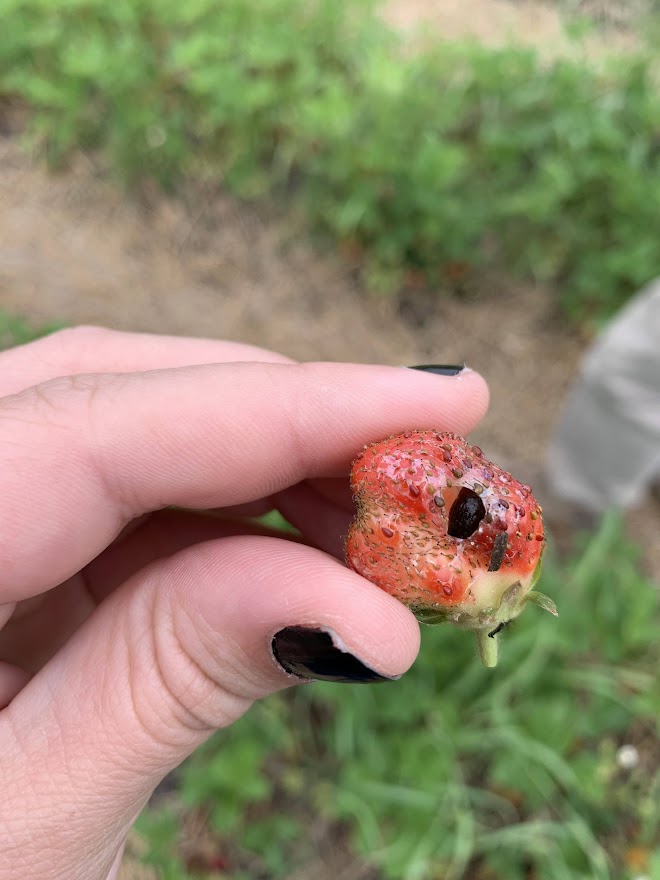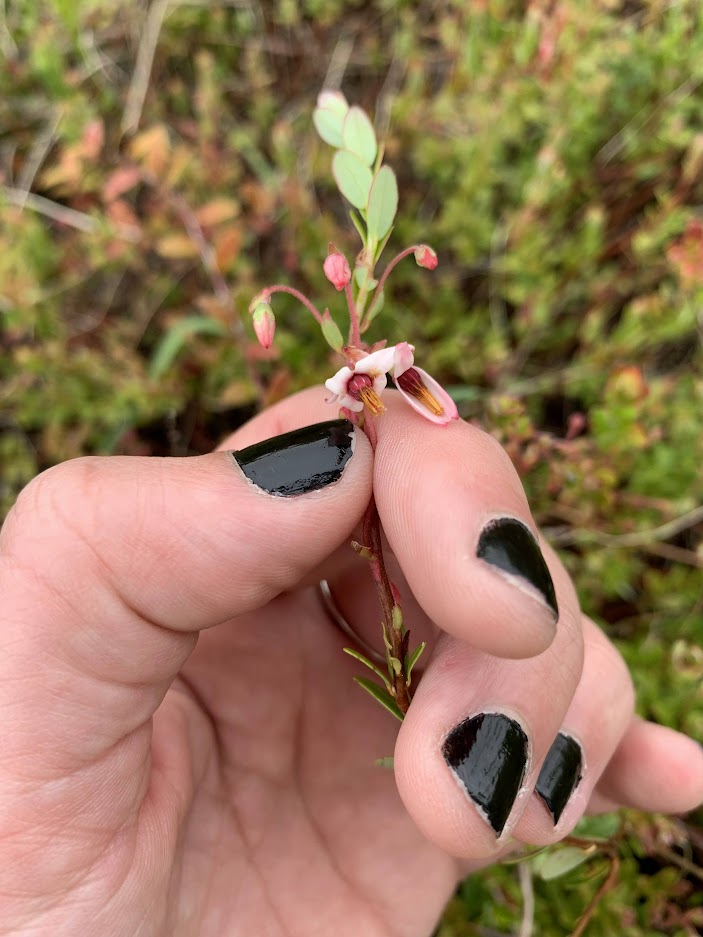Southwest Michigan fruit update – June 7, 2022
Bloom is finishing for most small fruit. Strawberry harvest has begun.

Weather
Last week was warmer than average. This was mainly because of the warm weather at the beginning of the week. Monday and Tuesday high temperatures were near 90 degrees. Lows were near 70. A cold front pushed through southwest Michigan on Wednesday bringing temperatures down to the mid to upper 70s where they stayed for the rest of the week.
Some parts of the area saw rain from the cold front on Wednesday, then again with another system that entered the region on Sunday and stayed through this morning. Most saw rain amounts of around a tenth of an inch before last night. In the last 24 hours most stations have reported between a third and over an inch of rain.
This week will be cooler. High temperatures will be around 70 degrees all week with cooler temperatures near the lake shore. Lows will be in the low 50s most of the week as well. Another storm system will pass through southwest Michigan Wednesday afternoon. Rain is also expected on Friday.
With the warm start to last week, we picked up an above average number of degree days,168 growing degree days (GDD) base 42, 113 GDD base 50.
|
Southwest Michigan GDD Summary from March 1 through June 6, 2022 |
|||
|
Station |
GDD 42 F |
GDD 45 F |
GDD 50 F |
|
Benton Harbor (SWMREC) |
1036 |
857 |
598 |
|
Lawton (Lawton) |
1029 |
851 |
596 |
|
Fennville (TNRC) |
938 |
767 |
523 |
|
Average for the SW region |
1025 |
848 |
593 |
|
Average last week |
857 |
701 |
480 |
Tree fruit
Tree fruit crops are beginning their natural June drop. With the sunny weather and high evapotranspiration rates this past week, trees in drought prone areas may start showing stress as the soils continue to dry out.
Newly planted trees may have bloom which are attractive to bees and other pollinators. Be cautious with sprays, avoiding when possible, and spraying at night when necessary to avoid harming pollinators. Plum curculio egg laying damage on fruit has slowed with the ending of the reproductive cycle of the current generation.
Estimated emergence of San Jose scale crawlers is 400 to 450 degree days base 51 after the biofix. The biofix was the start of male flight biofix on May 16, 2022 according to the Trevor Nichols Research Center trapline. As of late Monday the current DDbase51 total = 256.
Codling moth is being caught in traps in higher numbers than last week. Oriental fruit moth flight is ending. Obliquebanded leafroller flight should begin this week.
Apricot fruits are at 1 to 1-1/8 in in diameter. The crop is generally light, but better than last year.
Peach and nectarine fruit size increases are showing what fruit will stick and what fruit will drop. Redhaven fruit at SWMREC are 25 mm. Hand thinning will start soon. Estimated harvest date for Redhaven for Berrien County is August 1, about average. Crop potential is generally good. Oxytetracycline should be used instead of copper for bacterial spot to reduce chances of phytotoxicity. Rusty spot management is needed after shuck split for susceptible peach varieties. Peach scab management is needed now. Both lesser and greater peach tree borer adults are flying. Pheromone disruption for these two pests, if being used, should be in place as soon as practical.
In cherries, sweet cherries are at 15mm, tarts are at 13mm diameter. June drop is starting. Tart cherry crop potential looks good for SW Michigan. ProGibb treatment for suppression of bloom on young trees generally starts about 3 weeks after bloom. Cherry leaf spot control should continue.
In plums, Japanese plum are up to 20 mm and European plums are mainly around 18mm. Plum curculio egg laying activity has slowed. Continue black knot management on susceptible cultivars until terminal growth is generally halted.
Apple varieties range from 22 to 30mm in diameter. Seeds are turning brown in fruit that will drop. Natural June drop is starting. Scab ascospores are still being caught at low levels, but the primary spore release period appears to be nearly over. May 15th was a fire blight infection period and symptoms from this infection started showing up May 30th. Tarnished plant bug and green fruitworm damage has been seen in the area. Tarnished plant bug becomes active when we see temperatures above 70. Treatments after bloom are typically common for this pest. Codling moth egg hatch is likely underway. Egg hatch is when treatments typically start for this pest.
Pears are at 18 to 20mm in diameter. Pear psylla adults are present in some blocks. Powdery mildew symptoms are present on terminal foliage of pears. This is the same strain commonly found on apples, but rarely on pears.
Small fruit
Juice grapes and many hybrid wine varieties are blooming. Bloom disease management of phomopsis, black rot, downy and powdery mildews are the primary focus currently. In wine grapes, materials to control botrytis should be included in the sprays. Wild grape bloom is ending; many areas reached full bloom at the end of last week. Wild grape bloom (5/27-5/30/22) is used as the biofix for grape berry moth management later in the season.
Blueberry bloom has ended. The largest fruit observed in Van Buren County were about 12 mm. Disease focus should be on early fruit rot management. Cranberry fruitworm are being caught in pheromone traps. Cherry fruitworm moth catch is expected as well. According to Enviroweather, egg laying should be underway for both species. Fruit are required for egg laying and damage, so management usually begins after fruit set when egg laying begins. Second applications of fertilizer are being applied and weed control sprays are continuing.
Strawberry harvest is here for early varieties in southern locations. All the leaves are out by now: maintain fungicide coverage to protect the leaves and help prevent botrytis as fruit begin to show. Slugs have been reported in some fields.

Bramble bloom is ending in raspberries and blackberries. Raspberry sawfly scouting should begin. This insect eats leaf tissue between the veins giving them a skeleton-like appearance.
Cranberries have greened up. Upright growth has begun, and flowers are visible as hooks. Bloom should begin soon.

Hops are over 6 feet tall at this time. Downy mildew spikes are showing up more often. Early season management is important to stay ahead of this disease in hops.
Paw paws bloom has ended.
Upcoming meetings
Our regular Southwest Michigan Monday Fruit IPM Updates has moved to a hybrid format. The meetings are being held in person with virtual attending also available online. Our meetings are on Mondays beginning at 5:30 p.m. You do need to register to receive the Zoom link and password for these meetings. A link is emailed each Monday morning for that evening’s update. The webinars are free of charge and two pesticide applicator credits and certified crop advisor credits are available for each meeting.
The Southwest Michigan Viticulture Field Day will return to the Southwest Michigan Research and Extension Center for 2022. As tradition holds, the event will be the last Wednesday of July (July 27) and include presentations of ongoing research in southwest Michigan. The event will once again conclude with a steak dinner and local wine tasting. Registration information to come soon.
Related articles
- 2022 Fruit insecticide registration update
- Southwest Michigan fruit update – May 31, 2022
- Michigan grape scouting report – June 1, 2022
- Southwest Michigan fruit update – 2021 review
- Managing bacterial canker in sweet cherries: What are the options?
This work is supported by the Crop Protection and Pest Management Program [grant no 2021-70006-35450] from the USDA National Institute of Food and Agriculture.



 Print
Print Email
Email
